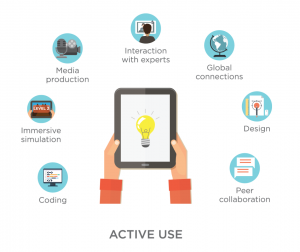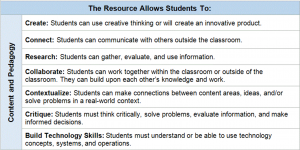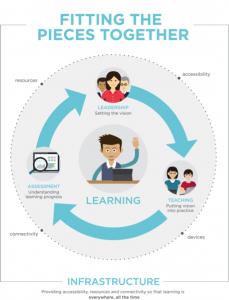In Module 6, I learned about technology use in the classroom and teaching in the 21st Century. The most important point I learned from Module 6 is to reflect on what I have learned about technology use in a classroom and when I become a teacher to ask myself does this technology incorporation open doors for learning or does it hinder the learning process?
Technology has the ability to be a beneficial asset to the classroom-learning environment. Woolfolk (2014) argues the main objective for putting technology into a class is to “support student learning” (p. 428). According to Woolfolk (2014) “with developmentally appropriate computer activities, young children can benefit cognitively without sustaining losses in creativity” (p. 429). Woolfolk (2014) argues technology is great when it requires the students to have “active engagement” and “frequent interaction with feedback” (p. 430). According to Loveless (1997) when technology is used through “interaction” where students can expand on their thoughts and designs along with “the teacher’s pedagogy” education in an art class can rise. (p. 107). When the technology is communicating with the student and having the student use critical thinking to complete a task or question, the student will be engaged rather than passively using the technology. For example, as a future art educator, preferably at the high school level, I will integrate multiple technology programs. In an art class, technology can be used to instill critical thinking for students when trying to come up with a solution for a problem with a picture in Photoshop. The problem might even have different methods to reach the same solution.
The image below from the U.S. Department of Education displays the different areas students can interact with technology in an active manner.
According to Adams Becker, Freeman, Giesinger Hall, Cummins, and Yuhnke (2016) technology can help students critically think and gain higher levels of learning (p. 14). Adams Becker et al. (2016) give the example of how social media provides access to material written and as an avenue to post their perspectives along with making videos on current events (p.14). Adams Becker et al. (2016) furthers that though this technology use in the classroom, students are able to discover multiple programs (p. 14). With the use of social media in a classroom setting, students may find the assignments more interesting and relevant to their lives.
Here is a link to a video of a classroom where students become interested in finding their own research through technology usage in the classroom:
https://www.youtube.com/watch?v=TGoCPPBkAg0&feature=youtu.be&list=PLE598F6CF3B38EE31
Another aspect to using the Internet and technology for research is that anyone can post anything on the Internet. Teachers need to teach the importance of fact-checking and what makes a source reliable. Riddle (2017) elaborates on the importance of using precarious eyes when reading information on the Internet and students need to learn what is academically appropriate and dependable when finding references (para. 4).
When technology is not used appropriately, it can hinder or block the learning process for students. According to Loveless (1997) “technology in the classroom does not guarantee quality learning for the children” she furthers with technology can be successful in the classroom if it is used as a “tool” and “resource that provides access” for creating new things (p. 107). When students are using technology in the classroom it is significant that the technology is user friendly and is monitored so that students are not off-task. According to Woolfolk (2014) “games that require multiple activities, visual attention, imagery, and fast action support the development of visual skills, as long as the task fit the student’s level of ability (p. 430).
From our face-to-face discussion on 5/2 I received a packet with the information in the image below. I learned when implementing a technology into a classroom it is important to review how the technology benefits students through creating, connecting, researching, collaborating, contextualizing, critiquing and building technology skills.
In order for technology to be beneficial for classroom learning it is extremely important for pre-service teachers to gain knowledge and skills for integration of technology in classrooms. Kimmons, Miller, Amador, Desjardins, and Hall (2015) conducted a study on pre-service teachers looking at how their studies have developed their knowledge of technology and creativity to implement technology in the future (p. 826). Kimmons et al. (2015) found that “the manner in which student self-assess on technology competency does not reflect critical thinking about meaningful applications of technology in educational contexts” (p. 827). According to Kimmons et al. (2015) teaching in the classroom with technology is incredibly complicated and it forces “teachers to become self-regulated learners” for integrated technology into their classroom when focusing on “cognition, metacognition and motivation” (p. 812). Teachers need to evaluate how their students will be using technology to gain knowledge and skills. From looking at the research it is important to have technology be an asset and not a crutch that holds back student learning. According to Kimmons et al. (2015) “pre-service teachers” need to alter the way they see technology from a “content area” to a resource for building student education (p. 812).
The image below from the U.S. Department of Education displays the way technology can be integrated into learning.
Technology is an important tool in our society and culture. It is commonplace and everywhere. According to Wang and Reeves (2003) people believe that technology is vital to education now because of the current “e-culture” (p. 54). Wang and Reeves (2003) further with the notion that society relies on the Internet to do so many things such as financial processes, social media, and retail ensuing that students be educated on how to survive in a forthcoming technology world (p. 54). According to Wang and Reeves (2003) technology implemented in the classroom is seen as a method to prepare students for constantly evolving and upgrading technology in an “e-society” (p. 54). Successful use of technology entails “pedagogical flexibility, support for teacher control and accessibility” (Wang & Reeves, 2003, p. 58). Technology is also successful when it can be “flexibly” put into an educator’s lesson and offer different avenues for learning and teaching while maintaining authority (Wang & Reeves, 2003, p. 58).
References
Active Use [Digital image]. (n.d.). Retrieved May 10, 2017, from https://tech.ed.gov/netp/learning/
Adams Becker, S., Freeman, A., Giesinger Hall, C., Cummins, M., and Yuhnke, B. (2016). NMC/CoSN Horizon Report: 2016 K-12 Edition. Austin, Texas: The New Media Consortium.
Fitting the pieces together [Digital image]. (n.d.). Retrieved May 10, 2017, from https://tech.ed.gov/netp/introduction/
Kimmons, R., Miller, B., Amador, J., Desjardins, C., & Hall, C. (2015). Technology integration coursework and finding meaning in pre-service teachers’ reflective practice. Educational Technology Research & Development, 63(6), 809-829.doi:10.1007/s11423-015-9394-5
Loveless, A. M. (1997). The visual arts and information technology in the classroom. Computers In The Schools, 13(1/2), 99.
Riddle, R. (2017, April 28). The true digital divide is around skills, not devices. Retrieved May 09, 2017, from http://www.educationdive.com/news/the-true-digital-divide-is-around-skills-not-devices/441442/
“Technology in the classroom.” YouTube, uploaded by John Croyle, 6 March 2012, https://www.youtube.com/watch?v=TGoCPPBkAg0&feature=youtu.be&list=PLE598F6CF3B38EE31.
Wang, F., & Reeves, T. C. (2003). Why Do Teachers Need to Use Technology in Their Classrooms? Issues, Problems, and Solutions. Computers In The Schools, 20(4), 49-65. doi:10.1300/J025v20n04_05
Woolfolk, A. E. (2014). Educational psychology: active learning edition (12th ed.). Boston: Pearson.




